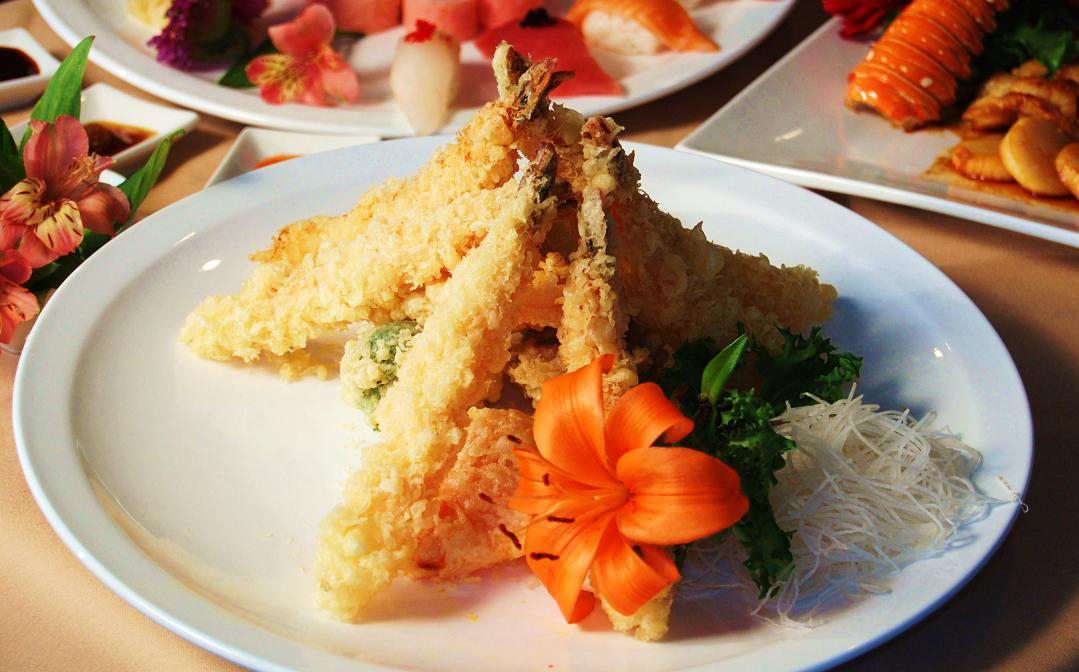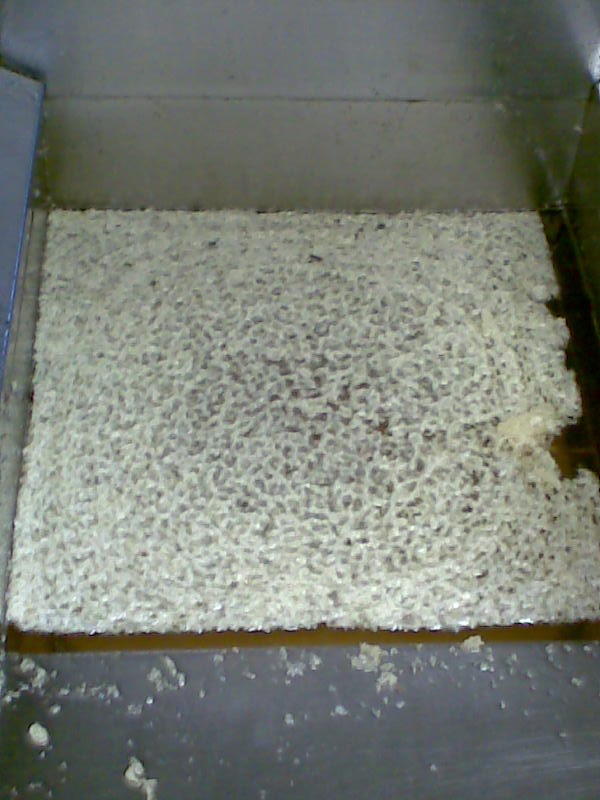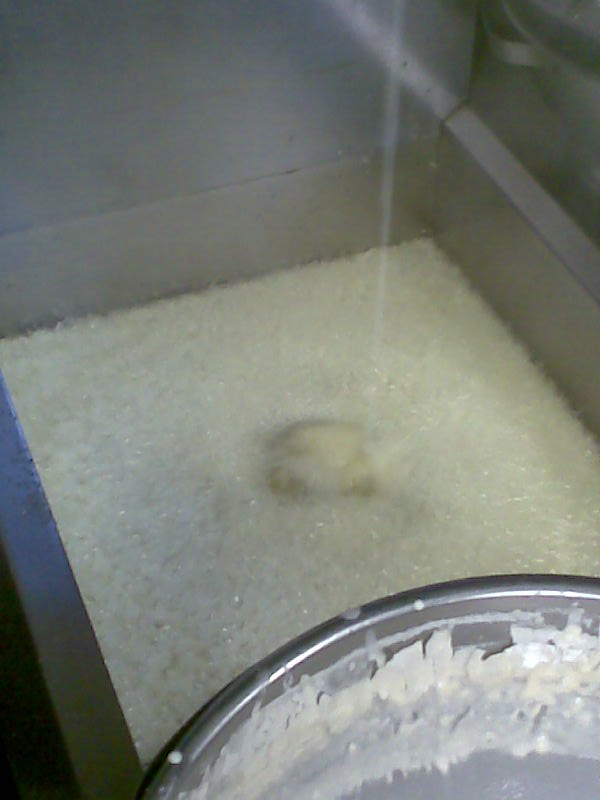“It looks easy,” Frank told me as he moved the circular, steel mesh strainer through the vegetable oil, scooping out the tempura flakes clumped together like bunches of oats. “But tempura takes some of the greatest skill in Japanese cooking.”
He switched to the rectangular strainer – a squirrel-sized hockey stick, with a steel mesh blade instead of wood. He dipped it into the yellow oil, and lifted it out, covering the surface with an even layer of tempura flakes. His left hand reached across his body, and with two quick plunges into the white batter, coated the long strip of shrimp. It looked like French fries in Europe; long, slender, dipped in mayonnaise. He laid it atop the tempura flakes, and placed it back in the oil. Gently, he pressed it against the wall of the deep fryer, and as he released the pressure, angled the strainer so it slowly rotated, giving the entire surface area the opportunity to be coated with flakes. He repeated the rotation a few times, before letting the shrimp fully cook in the hot oil.
When he finally pulled the shrimp out, we examined his battering technique. The entire surface was coated, but not in a single, even layer. Tempura flakes stuck out in odd places, like a Bart Simpson haircut.
“Like I said, it takes some skill,” he repeated.
Tempura Batter
- Fill large metal bowl with 2 ½ pints of tempura batter powder.
- Add an egg.
- Add water, mix. The mix should be free of lumps, and a smooth, even consistency.
- The batter serves as both the flaky coating on tempura dishes, and the coating layer on the meats and vegetables.
Tempura gets a bad rep. Partly because it’s deep-fried, and any yahoo at the County Fair can work an Oreo or a Twinkie in his deep-fryer. And partly because the responsibility falls onto the sous chef, while the head chef handles the stove. But there are enough intricacies that not only make it a valued skill, but one that requires knowledge and practice to become proficient.
The coating on the protein you serve must be light and even. There have to be enough flakes for consistency, but not so overdone that all you can taste is the batter. Coating the vegetables requires hand speed and efficiency, dipping from powder to batter to the oil with the fewest number of movements.
In fact, the whole process of creating a tempura dish was meant to be done slowly, with meticulous precision. But the popularization of Japanese cuisine has made speed a necessity.
Chen sifu watches me pour the batter into the oil – I keep the ladle high above my head, and the liquid seeps off the top, slides over the sides, and gravity gives it a one-two boot. It plunges into the pond of hot oil waiting calmly below, splashing and breaking serenity like the alcoholic uncle arriving late to Christmas dinner, in a fanfare of fizzles and flair. Immediately, pale yellow flakes bloom and race across the surface. The flakes drift in even, concentric circles outwards, carried by bubbles and small waves reverberating throughout the deep fryer, resembling a patchwork quilt of crisp autumn yellow.
I watch these flakes cook for a few seconds; some pieces clumped up into large, continental land masses. They’re no good to me, so I scoop them into the trash. This batch isn’t made to coat anything; they go directly to the sushi bar, and will eventually put the “crunch” in crunchy rolls. The flakes that remain are still a bit thicker than I remember, but the batch looks close enough. I scoop and place them into a large strainer resting above the other deep fryer, to let excess oil drip before giving it to the sushi bar.
It’s not until after the third batch does Chen sifu examine my handiwork.
He inspects the flakes straining to the side. He flicks his wrist once, twice, sifting through the contents.
“No good,” he says. He dumps it into the garbage can. He ushers me out of the way, and examines the batter I’m using.
“Too thick.” He adds water and mixes. Then he begins pouring it into the oil, ladle high above his head, using a small circular motion so the batter doesn’t just strike one area in the deep fryer. Among the chefs who work the deep fryer, Chen sifu is the most skilled. No matter the volume of orders, all his protein come out evenly coated, cooked till crispy and not a second longer. Not an easy thing to manage.
I watch his flakes blossom. His don’t clump together, and are in noticeably smaller pieces than the ones I managed to come up with. The thin layer of flakes that eventually float to the top form almost a crystalline structure on the oil, a web of tempura, bonded like ionic.
“Oh,” I say. “That’s good?”
He shakes his head. “No. Still not good.” With quick flicks of the wrist, he uses the rectangular strainer to slash through the oil. He pushes the flakes towards the wall of the fryer, and cuts at it by pressing layer by layer into the steel. There are no continental land masses. He dumps the batch into the steel strainer.
“Now, not bad.”
I try explaining to Asuk the best I can. The words are gibberish, a guttural mix of Chinese, Cantonese, and English. It’s not pretty but it gets the point across.
Look, when you put the flakes on the strainer, it’s too clumped together. Spread it out more – it needs to be one even layer. When you start pushing towards the wall, start further away; you’ll collect more flakes that way. Don’t spend five minutes rotating; either you did it right or you didn’t – you have to move on.
His dark, grizzled hand grasps the strainer like it’s a miniature teacup. It’s impossible to tell if his skin tone is from dirt or labor.
No, I tell him. Hold it like you mean it. I push the handle further into his hand.
He nods, readjusts, and we continue.
It’s frustrating watching Asuk work. It’s not so much he hasn’t learned properly, but he wasn’t taught properly. Chinese people, they think practice make perfect. So they’ll let you struggle on your own, barely taking note of your mistakes, only noticing if your end result is passable. If it isn’t, you’re berated. If it is, you’re grunted at. Chef barely pays him any attention when he starts his pour, so no one notices the batter’s too thin.
Practice doesn’t make perfect.
Perfect practice makes perfect.
He dips one piece of shrimp into the batter.
No – both at the same time. I demonstrate. How are you going to do 10 pieces, one at a time?
He scoops out flakes from the oil.
Too bunched up, I tell him. I redunk the strainer for him, spreading out the flakes. This is what it should look like.
He starts to place the protein onto the thin layer of flakes I collected for him. I guide his leathery mitt. Move the strainer close, so you don’t drip more batter into the oil.
When he puts the shrimp in, he remembers to start from a distance, at least. But his rotation is slow, and the long shrimp just plunges into the oil, without first getting its coat of pre-cooked flakes. He tries futilely to save the protein; thrashing and rotating, like a toddler trapped in the deep end. When he pulls the shrimp out, it’s clear the lifeguard didn’t reach him in time.
Asuk look dejected.
Don’t worry about it, I say. I pat him on the back. Just do it again. You know, tempura takes the most skill in Japanese cooking?
He pours the batter, ladle high. The flakes blossom. They march across the oil. We watch. We try again.
Photo Credit: Chrissie




2 Comments
I love your post. I’ve been trying to learn how to cook shrimp tempura right. And this is the same process I am trying to do. Do you have a video by any chance how he does it? So the batter should be runny? no lumps? I have read online that mixing it too much will activate gluten, resulting to pancake like coating. Thank you so much for posting this it really helps!
Hey Kino – I wish I had a video! When I visit the restaurant during the holidays, I’ll see if I can shoot some video and post it. Yes, the batter should have no lumps, but not exactly runny. The closest comparison I can think of in terms of its consistency is pancake batter — once it’s this consistency, you can stop mixing. Best of luck!